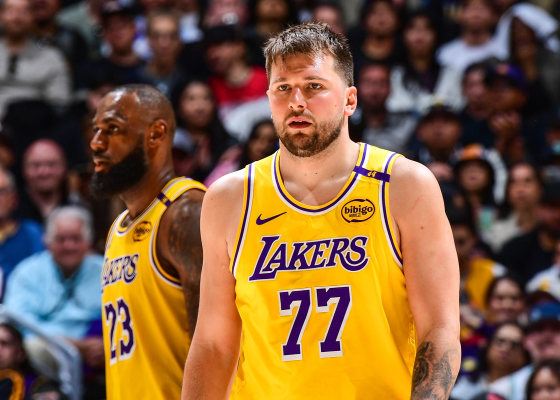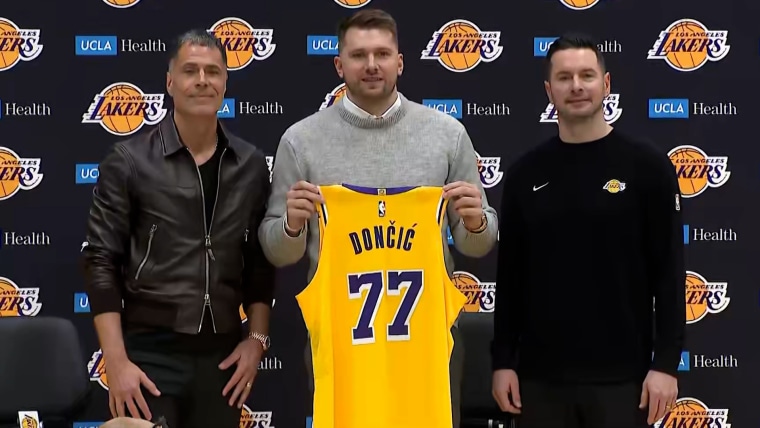The underdog Timberwolves have a commanding 3-1 series lead, and the Lakers’ inability to stop their opponents from piercing their interior defense with ease could be their downfall.

Even during the NBA’s 3-point explosion era, the most valuable real estate on the court remains the few feet surrounding the rim.
Modern offenses, despite what the box score may show, are still built on attacking the hoop. And modern defenses are still primarily constructed on taking that space away. It’s often how much emphasis teams place on trying to take away shots in the paint that leads to 3s for the offense in the first place.
In no first-round series this postseason has the importance of shots at the hoop been more evident than the one between the Los Angeles Lakers and the Minnesota Timberwolves.

Los Angeles Lakers introduce Luka Dončić after trade that was ‘a big shock’ 01:34
The underdog Timberwolves have a commanding 3-1 series lead heading into Game 5 on Wednesday. And if the Lakers ultimately lose the series, their inability to stop Minnesota from piercing their defense with ease will be their downfall.
Los Angeles made the biggest splash of perhaps the decade when it acquired Luka Dončić in early February. The trade was a no-brainer for the Lakers in the long term, acquiring a megastar in his prime who can lead the franchise for the next decade.
In the short term, Los Angeles gave up its best interior defender in Anthony Davis, and after the Lakers backed out of a trade to acquire Charlotte Hornets center Mark Williams at the deadline, they’ve been left perilously thin in the middle. That flaw is being exposed relentlessly against the Timberwolves.
Of the 16 teams in the playoff field, Minnesota is averaging the most shots per game in the restricted area — the area of the paint closest to the rim — taking 28.3 field goal attempts a night there. The Timberwolves are also averaging the most points per game on drives among postseason teams, with 32.3. (Both figures are higher than what Minnesota averaged during the regular season.)
“The fact is, we don’t have rim protection,” Los Angeles head coach JJ Redick said after their Game 3 loss. “So if you give up blow-bys, we’re going to give up something. We’re going to give up a 3 or give up a shot from [Anthony Edwards] at the rim.”
The Timberwolves have been so good at attacking the paint against Los Angeles that they are the only team in the first round leading their series despite having made fewer 3-point field goals than their opponent.
The Lakers don’t have great options to slow down Minnesota.
Los Angeles’ starting center, Jaxson Hayes, has played only 31 minutes through the series’ first four games, as he hasn’t been able to make an impact on either end of the floor. The Lakers’ starting lineup of LeBron James, Dončić, Austin Reaves, Hayes and Rui Hachimura has played only 26 minutes together, and it has been outscored by 19 points in that time.
Hayes, despite his size, isn’t a feared presence. He is foul-prone (eight fouls compared with 7 points this series), and his inability to guard on the perimeter leaves the team vulnerable to 3s.
Redick has tried to compensate by playing a smaller lineup, subbing Hayes out for small forward Dorian Finney-Smith. The James-Doncic-Reaves-Hachimura-Finney-Smith group played the entire second half of the Lakers’ Game 4 loss. While that fivesome has played better than the starting lineup, it has also been outscored by nine points in 70 minutes.
“If [Hayes] is not on the court, I’m basically the tallest person out there,” Timberwolves forward Jaden McDaniels said after he scored 25 points in Game 1.
McDaniels has been one of the biggest beneficiaries of Los Angeles’ lack of defense, averaging 19.8 points in the first round, a stark improvement from his regular-season average of 12.2. He is shooting 72% inside the restricted area, and the percentage of his points in the paint is 63.3%, up from 52.8% before the playoffs.
Edwards, though, has been the head of the snake.
Edwards is averaging 29.8 points per game in the postseason, and he’s getting wherever he wants on the floor. Of his 93 field-goal attempts against the Lakers, he has taken 48 in the paint (where he’s shooting 52.1%) and 37 from 3 (where he’s shooting 43.2%).
Led by Edwards’ ability to get into the paint with ease and his pull-up shooting prowess, the Timberwolves have leveraged Los Angeles’ defense to the brink. They’ve been adept at hunting mismatches and creating open looks, giving the Lakers nowhere to hide.
Dončić has especially been targeted when Los Angeles goes small, displaying some of the defensive concerns that caused the Dallas Mavericks to trade him in the first place.
A common Minnesota possession against the Lakers features Edwards calling for his teammate guarded by Dončić up for a screen. That makes Dončić the primary defender on Edwards, who promptly attacks the rim. Edwards is shooting 60% on field-goal attempts when he is guarded by Dončić in the first round.
Los Angeles’ defense gave up 113.8 points per 100 possessions during the regular season, 17th in the NBA. Against Minnesota in the first round, the Lakers are giving up 118.9 points per 100 possessions, which would have been 29th — worse than the 18-64 Washington Wizards.
“Just got to do a better job of staying in front of the ball,” Finney-Smith said after Game 3 about how the team can stop the rim attacks. “I feel like we were just giving up too many blow-bys. It really didn’t have nothing to do with our size. It was the on-ball defense and rotation when we’ve got to scramble.”
Redick may have tipped his hand about his team’s lack of options when he stuck with the same five players for the entire second half Sunday — the first coach to do so since 1998. If Redick and Los Angeles can’t figure out a way to defend the most prized real estate on the court, Minnesota will be going to the second round.